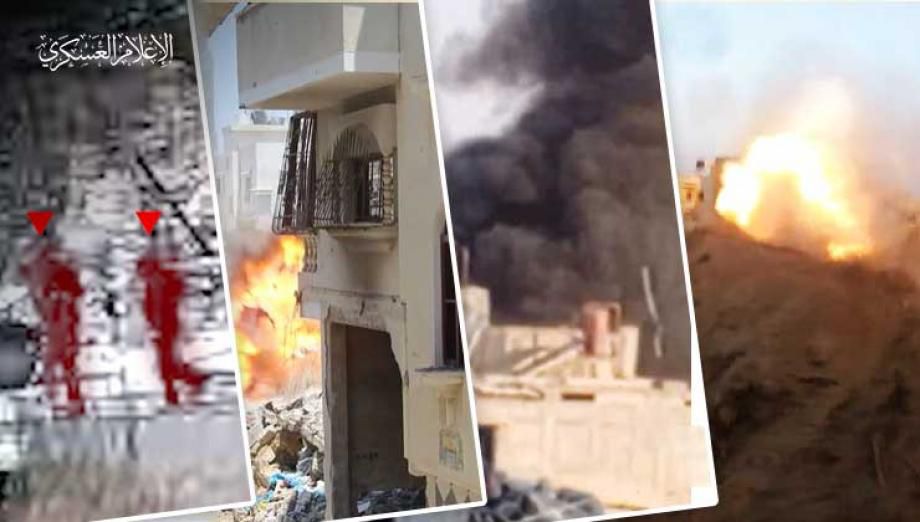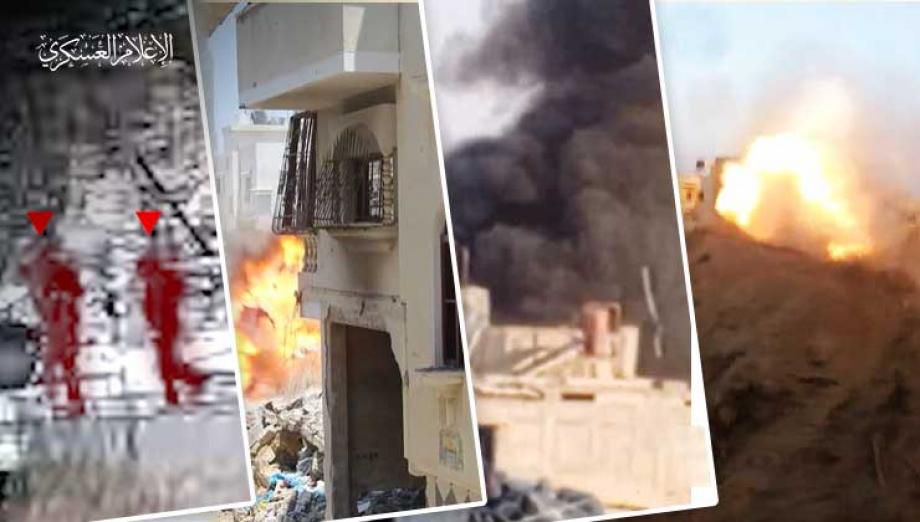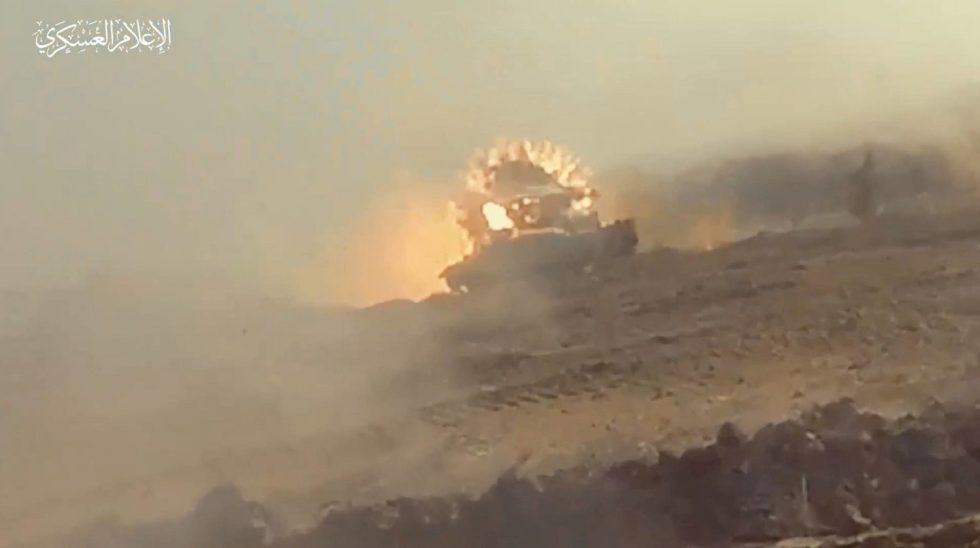
CAPITALS August 25. 2024 (Saba) -The Palestinian resistance continues its heroic confrontation with the Zionist enemy's vehicles and soldiers in the Gaza Strip with all its strength, according to the statements of its various factions, which confirm the elimination and trapping of the enemy forces in complex and various ambushes in the areas of ground penetration, which have so far resulted in the death of 696 officers and soldiers, and the injury of more than 4357 others, according to the latest statistics published by the enemy army.
In the midst of the fierce confrontations witnessed in the fighting axes in the Gaza Strip, especially in the Zeitoun neighborhood, the Palestinian resistance factions issued a number of military statements yesterday and today, Saturday, about the fierce clashes they are waging with the enemy forces, in which they confirmed that they have inflicted new losses in lives and equipment.
In this context, the military media of the Qassam Brigades issued details of the tight ambush during which soldiers from the Zionist enemy army were killed and wounded in the Zeitoun neighborhood in Gaza City.
The Qassam Brigades said in a military statement: Its members were able to target a number of Zionist enemy vehicles that had penetrated southeast of the Zeitoun neighborhood in Gaza City with "Yassin 105" shells.
It added: As soon as a foot force advanced towards one of the houses that had been previously booby-trapped with a number of anti-personnel bombs, they were detonated.
The Qassam Brigades confirmed that its members killed and wounded the force and that the Zionist helicopter landed to evacuate.
The Zionist enemy army radio reported that a force of reserve soldiers was combing buildings in the Zeitoun neighborhood in the Gaza Strip before reaching a building that turned out to be booby-trapped, which led to the death of a soldier and the injury of 12 others, four of whom are in critical condition.
In conjunction with this ambush, Al-Qassam broadcast a video clip of targeting the command and control center of the enemy army in the "Netzarim Axis" with a suicide drone without revealing the details of the attack. Before that, it announced targeting five Zionist vehicles in the Tel Sultan neighborhood in Rafah Governorate, and this Saturday afternoon, it targeted a number of enemy vehicles and engineering equipment in the military sites area east of Deir al-Balah with a previously prepared minefield.
In a statement, the Al-Quds Brigades said that its fighters engaged in fierce clashes with the enemy soldiers who had penetrated south of the Zeitoun neighborhood, and also shelled the enemy vehicles at the same axis with mortar shells.
In the central Gaza Strip as well, the Mujahideen Brigades announced that its fighters, in cooperation with the Al-Aqsa Martyrs Brigades, destroyed the enemy forces' supply line in the "Netzarim Axis" with several "107" missiles.
At a time when the Palestinian resistance factions were publishing details of their military operations, the Zionist website "Hadashot Hamot" reported that a "difficult security incident" had occurred in the Zeitoun neighborhood, southeast of Gaza City.
He added: An enemy army force was ambushed by the Palestinian resistance, by detonating a mine in the Zeitoun neighborhood east of Gaza City.
The Zionist military force was combing the area in the Zeitoun neighborhood to expand the "Netzarim axis" separating the north and south of the Gaza Strip.
The Zionist Broadcasting Authority said: An ambush was set up for the army forces by planting a mine next to a wall built in the Zeitoun neighborhood.
In conjunction with the Palestinian resistance operations, the Zionist enemy army announced that 696 soldiers were killed in the Gaza Strip, including 333 during the ground battles that began on October 27.
According to the data published by the enemy army on its website, the number of wounded soldiers reached four thousand and 357, including 2,232 who were injured in the ground battles.
These numbers were issued at a time when the Zionist entity is accused of concealing the true toll of the dead and wounded in Gaza, knowing that Zionist officials have stated more than once that the Zionist army is paying "heavy prices" in its battles inside the Strip, and is waging "fierce fighting" with the Palestinian resistance.
These figures were issued as the Zionist enemy army began to call up reserve fighters who had been exempted from service in recent years due to a shortage of its forces, amid difficulties in recruiting religious Haredim.
The enemy army said in a statement: "Defense Minister Yoav Galant ordered the return of those who were in the reserves and were previously exempted from service due to the reduction of forces, and who are still of service age."
According to military analysts, the ambushes deployed by the resistance in Gaza reveal a development in the resistance's work in the technical field and its use in the military battle after 11 months of war, in which the enemy army promoted that it had dismantled the capabilities of the resistance, so these ambushes undermined those claims, at a time when the resistance is writing heroic deeds on the battlefield that surprise the enemy.
Here, the Lebanese military and strategic expert Talal Atrissi confirms that the resistance is thus proving that it is not only in a defensive position and that it is still capable of fighting, and this gives it strength in the negotiations by not submitting to the conditions of the Zionist enemy.
Atrisi told Palestine Online: "The continuation of resistance operations in the absence of supplies means that the resistance is relying on the interior at all levels, whether in manufacturing, supply or protection, and that it was preparing itself for this war and preparing for it, and that the strategic planning for the war was clear and precise for these possibilities."
He believed that the resistance operations indicate the great confusion experienced by the Zionist enemy army, which was promoting that the battle of Rafah would end the resistance, but the resistance's cohesion in managing its operations increased the state of frustration among the occupation army, which began to demand a ceasefire, while the political level wanted to continue the war, and this deepens the contradiction between the two sides.
He believes that the continuation of this type of tactics makes us feel as if we are living the first days of the battle, and puts the resistance in a better position in front of the exhausted Zionist enemy army.
In the midst of the fierce confrontations witnessed in the fighting axes in the Gaza Strip, especially in the Zeitoun neighborhood, the Palestinian resistance factions issued a number of military statements yesterday and today, Saturday, about the fierce clashes they are waging with the enemy forces, in which they confirmed that they have inflicted new losses in lives and equipment.
In this context, the military media of the Qassam Brigades issued details of the tight ambush during which soldiers from the Zionist enemy army were killed and wounded in the Zeitoun neighborhood in Gaza City.
The Qassam Brigades said in a military statement: Its members were able to target a number of Zionist enemy vehicles that had penetrated southeast of the Zeitoun neighborhood in Gaza City with "Yassin 105" shells.
It added: As soon as a foot force advanced towards one of the houses that had been previously booby-trapped with a number of anti-personnel bombs, they were detonated.
The Qassam Brigades confirmed that its members killed and wounded the force and that the Zionist helicopter landed to evacuate.
The Zionist enemy army radio reported that a force of reserve soldiers was combing buildings in the Zeitoun neighborhood in the Gaza Strip before reaching a building that turned out to be booby-trapped, which led to the death of a soldier and the injury of 12 others, four of whom are in critical condition.
In conjunction with this ambush, Al-Qassam broadcast a video clip of targeting the command and control center of the enemy army in the "Netzarim Axis" with a suicide drone without revealing the details of the attack. Before that, it announced targeting five Zionist vehicles in the Tel Sultan neighborhood in Rafah Governorate, and this Saturday afternoon, it targeted a number of enemy vehicles and engineering equipment in the military sites area east of Deir al-Balah with a previously prepared minefield.
In a statement, the Al-Quds Brigades said that its fighters engaged in fierce clashes with the enemy soldiers who had penetrated south of the Zeitoun neighborhood, and also shelled the enemy vehicles at the same axis with mortar shells.
In the central Gaza Strip as well, the Mujahideen Brigades announced that its fighters, in cooperation with the Al-Aqsa Martyrs Brigades, destroyed the enemy forces' supply line in the "Netzarim Axis" with several "107" missiles.
At a time when the Palestinian resistance factions were publishing details of their military operations, the Zionist website "Hadashot Hamot" reported that a "difficult security incident" had occurred in the Zeitoun neighborhood, southeast of Gaza City.
He added: An enemy army force was ambushed by the Palestinian resistance, by detonating a mine in the Zeitoun neighborhood east of Gaza City.
The Zionist military force was combing the area in the Zeitoun neighborhood to expand the "Netzarim axis" separating the north and south of the Gaza Strip.
The Zionist Broadcasting Authority said: An ambush was set up for the army forces by planting a mine next to a wall built in the Zeitoun neighborhood.
In conjunction with the Palestinian resistance operations, the Zionist enemy army announced that 696 soldiers were killed in the Gaza Strip, including 333 during the ground battles that began on October 27.
According to the data published by the enemy army on its website, the number of wounded soldiers reached four thousand and 357, including 2,232 who were injured in the ground battles.
These numbers were issued at a time when the Zionist entity is accused of concealing the true toll of the dead and wounded in Gaza, knowing that Zionist officials have stated more than once that the Zionist army is paying "heavy prices" in its battles inside the Strip, and is waging "fierce fighting" with the Palestinian resistance.
These figures were issued as the Zionist enemy army began to call up reserve fighters who had been exempted from service in recent years due to a shortage of its forces, amid difficulties in recruiting religious Haredim.
The enemy army said in a statement: "Defense Minister Yoav Galant ordered the return of those who were in the reserves and were previously exempted from service due to the reduction of forces, and who are still of service age."
According to military analysts, the ambushes deployed by the resistance in Gaza reveal a development in the resistance's work in the technical field and its use in the military battle after 11 months of war, in which the enemy army promoted that it had dismantled the capabilities of the resistance, so these ambushes undermined those claims, at a time when the resistance is writing heroic deeds on the battlefield that surprise the enemy.
Here, the Lebanese military and strategic expert Talal Atrissi confirms that the resistance is thus proving that it is not only in a defensive position and that it is still capable of fighting, and this gives it strength in the negotiations by not submitting to the conditions of the Zionist enemy.
Atrisi told Palestine Online: "The continuation of resistance operations in the absence of supplies means that the resistance is relying on the interior at all levels, whether in manufacturing, supply or protection, and that it was preparing itself for this war and preparing for it, and that the strategic planning for the war was clear and precise for these possibilities."
He believed that the resistance operations indicate the great confusion experienced by the Zionist enemy army, which was promoting that the battle of Rafah would end the resistance, but the resistance's cohesion in managing its operations increased the state of frustration among the occupation army, which began to demand a ceasefire, while the political level wanted to continue the war, and this deepens the contradiction between the two sides.
He believes that the continuation of this type of tactics makes us feel as if we are living the first days of the battle, and puts the resistance in a better position in front of the exhausted Zionist enemy army.

